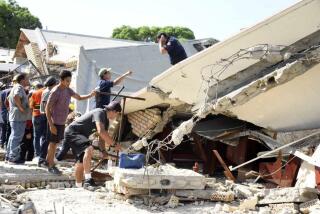No Money to Repair Damaged Colonial-Era Churches : Ecuador Still Shows Some Scars From ’87 Earthquake
- Share via
QUITO, Ecuador — Magnificent colonial churches in the Ecuadorean capital damaged in a severe earthquake last year are neglected, decaying and in danger of collapse.
Architects, restoration experts and church officials say several churches have had scant restoration work performed since emergency patch-up operations right after the March, 1987, earthquake, which hit hardest a remote area about 60 miles northeast of Quito, killing more than 1,000 people.
Built by Spanish settlers and adorned with gold, paintings and murals by Spanish and Indian artists depicting early Christian miracles, the churches are now wrapped with scaffolding. Wide fissures threaten walls and arches.
Church officials and restoration experts fear that the churches could collapse altogether in another tremor.
Janet Silva, an architect working on church restoration, said many churches were already weakened by centuries of wind, rain and previous earthquakes.
Jose Maria Jaramillo, director of the state-run National Institute of Cultural Patrimony, said most of the 40 to 50 buildings damaged in Quito were churches. The northeastern city of Ibarra, including Basilica de la Dolorosa, also suffered quake damage.
Worst hit in Quito were the Convent of Santo Domingo, the Church of San Agustin run by Aguirre, and Convent de la Merced, a famous old church not far from Quito’s Plaza Independencia.
The Convent de la Merced houses one of the largest church bells on the continent, a gold, silver, zinc and bronze instrument measuring about 16 feet across and 7 feet high. Sharing the bell tower is one of the oldest clocks, made in London and installed in the 19th Century.
Father Octavio Proano, the padre at La Merced and the author of several books on Quito church architecture, said no one has rung the bell since the quake damaged the tower and showered stones on the bell.
The clock, which carries the inscription Handle and Moore, Clerkenwell, 1817, was wrecked by falling walls during the quake.
For more than 40 years, one Ecuadorean man, Seferino Congo, had maintained the clock, scaling the 57-meter tower twice a day. When he died in 1965, no one was willing to make the scary ascent, and the clock stopped.
“Of course we could restore the clock,” Proano said, “but that would cost a lot of money that we don’t have.”
His plaint is repeated by nearly everyone with a role in church restoration.
Ecuador is the second poorest country in South America, and the quake damaged its oil pipeline, eating into a key revenue source.
Jaramillo said in an interview that his group needed at least $6 million to restore the Quito churches. The government granted only $40,000.
The Organization of American States had approved $30,000 for restoration, and the United Nations was expected to approve $130,000, but these sums were nowhere near those required to repair the damaged buildings, he added.
The Roman Catholic Church in Ecuador, also strapped for money, has few resources for church repairs, said Padre Angel Aguirre, who runs San Agustin, a 17th-Century church that was badly damaged.
What repairs that are being undertaken are financed by the patrimony institute, the clergy and a local beer firm.
More to Read
Sign up for Essential California
The most important California stories and recommendations in your inbox every morning.
You may occasionally receive promotional content from the Los Angeles Times.










